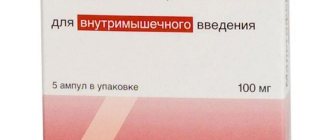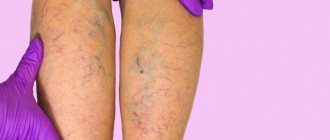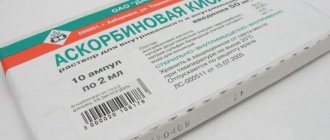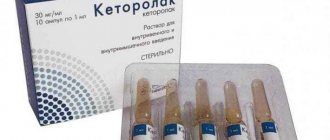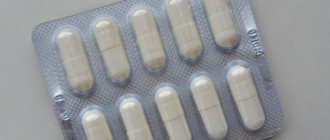Compound
The injection solution contains sodium heparin at a concentration of 5 thousand units/ml.
The auxiliary components of the drug include sodium chloride, benzyl alcohol, and water. 1 gram of gel contains 1 thousand units of sodium heparin , as well as auxiliary components: 96% ethanol, carbomer , dimethyl sulfoxide, propylene glycol, dietanolamine, methyl and propylparaben (additives E 218, E 216), lavender oil and purified water.
pharmachologic effect
Pharmacological group: anticoagulants .
Group of the drug Heparin, produced in the form of a gel: drugs for the treatment of cardiovascular diseases.
Group of the drug Heparin, produced in injection form: agents affecting blood and hematopoiesis.
Heparin sodium contained in the drug has an antithrombotic effect , slows down the aggregation and adhesion of leukocytes , platelets and erythrocytes ; reduces wall spasm and the degree of vascular permeability; helps improve collateral circulation.
What can be replaced
An analogue of Heparin is also a solution of a drug, but from a different production.
The following solution analogues exist:
- Sodium Brown.
- Richter.
- Frayn.
The use of these funds should be carried out after consultation with a specialist.
Thus, Heparin is a good drug for thinning the blood and preventing the development of blood clots inside blood vessels. However, during its use it is necessary to carefully monitor blood clotting parameters and follow the chosen therapeutic course.
Pharmacodynamics and pharmacokinetics
What is Heparin?
Heparin (INN: Heparin) is an acidic mucopolysaccharide with Mr about 16 kDa. A direct anticoagulant that helps slow down the formation of fibrin .
The gross formula of heparin is C12H19NO20S3.
Pharmacodynamics
The mechanism of action of heparin is based primarily on its binding to AT III (its plasma cofactor). Being a physiological anticoagulant , it potentiates the ability of AT III to suppress activated coagulation factors (in particular, IXa, Xa, XIa, XIIa).
When used in high concentrations, heparin also inhibits thrombin activity .
Suppresses activated factor X, which is involved in the internal and external blood coagulation system.
The effect occurs when significantly lower doses of heparin are used than are required to inhibit the activity of coagulation factor II ( thrombin ), which promotes the formation of fibrin from the plasma protein fibrinogen .
This justifies the possibility of using small doses of heparin (subcutaneously) for prophylactic purposes, and large doses for treatment.
Heparin is not a fibrinolytic (i.e., it is capable of dissolving blood clots), but it can reduce the size of the blood clot and stop its expansion. Thus, the blood clot is partially dissolved under the action of fibrinolytic enzymes of natural origin.
Suppresses the activity of the enzyme hyaluronidase, helps reduce the activity of surfactant in the lungs.
Reduces the risk of developing MI, acute thrombosis of myocardial arteries and sudden death. In small doses it is effective for the prevention of VTE, in high doses it is effective against venous thrombosis and pulmonary embolism .
Deficiency of AT III at the site of thrombosis or plasma may reduce the antithrombotic effect of the drug
When applied externally, the product has a local antiexudative , antithrombotic and moderate anti-inflammatory effect .
Promotes the activation of fibrinolytic properties of blood, inhibits the activity of hyaluronidase, and blocks the formation of thrombin. Gradually released from the gel and passing through the skin, heparin helps reduce inflammation and has an antithrombotic effect .
At the same time, the patient’s microcirculation improves and tissue metabolism is activated and, as a result, the processes of resorption of blood clots and hematomas are accelerated, and tissue swelling is reduced.
Pharmacokinetics
When used externally, absorption is negligible.
After injection under the skin, TCmax is 4-5 hours. Up to 95% of the substance is in a state bound to plasma proteins, Vp - 0.06 l/kg (the substance does not leave the vascular bed due to strong binding to plasma proteins).
It does not penetrate the placental barrier or into breast milk.
Metabolized in the liver. The substance is characterized by rapid biological inactivation and short duration of action, which is explained by the participation of the antiheparin factor in its biotransformation and the binding of heparin to the macrophage system.
T1/2 - 30-60 minutes. Excreted by the kidneys. Up to 50% of the substance can be excreted unchanged only if high doses are used. It is not excreted by hemodialysis.
Instructions:
Clinical and pharmacological groups
29.040 (Drug with proteolytic activity that promotes the resorption of keloid scars, for external use) 27.007 (Drug with antithrombotic and local anesthetic effects for local use in proctology) 29.018 (Drug with anti-inflammatory, antiexudative, analgesic, antithrombotic and tissue regeneration-improving effects for external use) 29.044 (Drug with antithrombotic and tissue regeneration improving effects for external use) 27.016 (Drug with anti-inflammatory, antibacterial, antithrombotic and local anesthetic effects for local use in proctology) 29.045 (Drug with antithrombotic, angioprotective, venotonic and tissue regeneration improving effects for external use) 29.043 (Drug with antithrombotic effect for external use) 29.046 (Drug with antithrombotic and venotonic effect for external use) 27.011 (Drug with antithrombotic, anti-inflammatory and venosclerosing effect for local use in proctology) 20.019 (Direct-acting anticoagulant - medium molecular weight heparin)
pharmachologic effect
Direct anticoagulant, belongs to the group of medium molecular heparins. In blood plasma, it activates antithrombin III, accelerating its anticoagulant effect. It disrupts the transition of prothrombin to thrombin, inhibits the activity of thrombin and activated factor X, and to some extent reduces platelet aggregation.
For unfractionated standard heparin, the ratio of antiplatelet activity (antifactor Xa) to anticoagulant activity (APTT) is 1:1.
Increases renal blood flow; increases cerebral vascular resistance, reduces the activity of cerebral hyaluronidase, activates lipoprotein lipase and has a hypolipidemic effect. Reduces the activity of surfactant in the lungs, suppresses excessive synthesis of aldosterone in the adrenal cortex, binds adrenaline, modulates the ovarian response to hormonal stimuli, and increases the activity of parathyroid hormone. As a result of interaction with enzymes, it can increase the activity of brain tyrosine hydroxylase, pepsinogen, DNA polymerase and reduce the activity of myosin ATPase, pyruvate kinase, RNA polymerase, pepsin.
There is evidence that heparin has immunosuppressive activity.
In patients with coronary artery disease (in combination with ASA), it reduces the risk of acute coronary artery thrombosis, myocardial infarction and sudden death. Reduces the frequency of recurrent infarctions and mortality in patients who have had myocardial infarction. In high doses it is effective for pulmonary embolism and venous thrombosis, in small doses it is effective for the prevention of venous thromboembolism, incl. after surgical operations.
With intravenous administration, blood coagulation slows down almost immediately, with intramuscular injection - after 15-30 minutes, with subcutaneous administration - after 20-60 minutes, after inhalation the maximum effect is within 24 hours; the duration of the anticoagulant effect is respectively 4-5, 6, 8 hours and 1-2 weeks, the therapeutic effect - prevention of thrombus formation - lasts much longer. Deficiency of antithrombin III in plasma or at the site of thrombosis may reduce the antithrombotic effect of heparin.
When applied externally, it has a local antithrombotic, antiexudative, and moderate anti-inflammatory effect. Blocks the formation of thrombin, inhibits the activity of hyaluronidase, and activates the fibrinolytic properties of the blood. Heparin penetrating through the skin reduces the inflammatory process and has an antithrombotic effect, improves microcirculation and activates tissue metabolism, thereby accelerating the processes of resorption of hematomas and blood clots and reducing tissue swelling.
Pharmacokinetics
After subcutaneous administration, the Cmax of the active substance in plasma is observed after 3-4 hours. Heparin penetrates poorly through the placenta due to its high molecular weight. Not excreted in breast milk.
T1/2 from plasma is 30-60 minutes.
Dosage
Individual, depending on the dosage form used, indications, clinical situation and age of the patient.
Drug interactions
The anticoagulant effect of heparin is enhanced by the simultaneous use of anticoagulants, antiplatelet agents and NSAIDs.
Ergot alkaloids, thyroxine, tetracycline, antihistamines, and nicotine reduce the effect of heparin.
Use during pregnancy and lactation
Use during pregnancy is possible only according to strict indications, under close medical supervision.
Possible use during lactation (breastfeeding) according to indications.
Side effects
From the blood coagulation system: possible bleeding of the gastrointestinal tract and urinary tract, bleeding at the injection site, in areas exposed to pressure, from surgical wounds, as well as hemorrhages in other organs, hematuria, thrombocytopenia.
From the digestive system: nausea, loss of appetite, vomiting, diarrhea, increased activity of “liver” transaminases.
Allergic reactions: skin hyperemia, drug fever, urticaria, rhinitis, itching and feeling of heat in the soles, bronchospasm, collapse, anaphylactic shock.
From the blood coagulation system: thrombocytopenia (can be severe and even fatal) with subsequent development of skin necrosis, arterial thrombosis, accompanied by the development of gangrene, myocardial infarction, stroke.
From the musculoskeletal system: with long-term use - osteoporosis, spontaneous fractures, soft tissue calcification.
Local reactions: irritation, pain, hyperemia, hematoma and ulceration at the injection site.
Other: transient alopecia, hypoaldosteronism.
Indications
Prevention and therapy: deep vein thrombosis, pulmonary embolism (including in diseases of the peripheral veins), coronary artery thrombosis, thrombophlebitis, unstable angina, acute myocardial infarction, atrial fibrillation (including accompanied by embolism), DIC- syndrome, prevention and therapy of microthrombosis and microcirculation disorders, renal vein thrombosis, hemolyticouremic syndrome, mitral heart disease (prevention of thrombosis), bacterial endocarditis, glomerulonephritis, lupus nephritis.
Prevention of blood clotting during operations using extracorporeal circulatory methods, during hemodialysis, hemosorption, peritoneal dialysis, cytapheresis, forced diuresis, when flushing venous catheters.
Preparation of non-clotting blood samples for laboratory purposes and blood transfusions.
Contraindications
Bleeding, diseases accompanied by impaired blood clotting, suspected intracranial hemorrhage, cerebral aneurysm, hemorrhagic stroke, dissecting aortic aneurysm, antiphospholipid syndrome, malignant arterial hypertension, subacute bacterial endocarditis, erosive and ulcerative lesions of the gastrointestinal tract, severe lesions of the liver parenchyma, cirrhosis liver with varicose veins of the esophagus, malignant neoplasms in the liver, shock conditions, recent surgical interventions on the eyes, brain, prostate gland, liver and bile ducts, condition after spinal puncture, menstruation, threatened miscarriage, childbirth (incl. recent), increased sensitivity to heparin.
Do not apply to open wounds, mucous membranes, and do not use in ulcerative-necrotic processes.
special instructions
Use with caution in patients suffering from polyvalent allergies (including bronchial asthma), arterial hypertension, dental procedures, diabetes mellitus, endocarditis, pericarditis, in the presence of an intrauterine contraceptive device, active tuberculosis, radiation therapy, liver failure, chronic renal failure, in elderly patients (over 60 years of age, especially women).
IM administration of heparin is not recommended due to the possibility of hematoma development, as well as IM administration of other drugs during heparin treatment.
Use externally with caution for bleeding and conditions of increased bleeding, thrombocytopenia.
During treatment with heparin, monitoring of blood clotting parameters is necessary.
To dilute heparin, only saline solution is used.
If severe thrombocytopenia develops (a decrease in the platelet count by 2 times the initial number or below 100,000/μl), it is necessary to urgently stop using heparin.
The risk of bleeding can be minimized with careful assessment of contraindications, regular laboratory monitoring of blood clotting, and adequate dosing.
Preparations containing SODIUM HEPARIN (HEPARIN SODIUM)
• HEPARIN OINTMENT ◊ ointment for external use. approx. 100 IU+40 mg+800 mcg/1 g: tubes 10 g or 25 g • HEPARIN-FEREIN solution for injection. 5 thousand IU/1 ml: amp. 5 pieces. • VENOLIFE® (VENOLIFE) ◊ gel for external use. approx. 20 mg+50 mg+2.5 mg/1 g: tubes 30 g or 40 g • VENITAN® FORTE ◊ gel for external use. approx. 10 mg+100 IU: tubes 50 g • HEPARIN-FEREIN solution for injection. 25 thousand IU/5 ml: fl. 1 PC. • HEPARIN (HEPARIN) solution for intravenous and subcutaneous administration 25 thousand IU/5 ml: vial. 5 or 10 pcs. • HEPARIN-FEREIN solution for injection. 25 thousand IU/5 ml: amp. 1 PC. • HEPARIN OINTMENT ◊ ointment for external use. approx. 100 IU+40 mg+800 mcg/1 g: tubes 10 g or 25 g • HEPARIN-SODIUM BRAUN solution for injection. 25 thousand IU/5 ml: fl. 10 pieces. • HEPATROMBIN ◊ gel for external use. approx. 500 IU+2.5 mg+2.5 mg/1 g: tube 40 g • HEPARIN solution for injections 5000 ED/ml solution for injection. 25 thousand IU/5 ml: fl. 5 pieces. • HEPARIN OINTMENT ◊ ointment for external use. approx. 100 IU+40 mg+800 mcg/1 g: tubes 10 g or 25 g • HEPARIN (HEPARIN) solution for intravenous and subcutaneous administration 5 thousand IU/1 ml: amp. 5 or 10 pcs. • HEPARIN (HEPARIN) solution for intravenous and subcutaneous administration 25 thousand IU/5 ml: amp. 5 or 150 pcs. • HEPATROMBIN ◊ gel for external use. approx. 300 IU+2.5 mg+2.5 mg/1 g: tube 40 g • HEPARIN (HEPARIN) solution for injection. 50 thousand IU/10 ml: fl. 1 PC. • HEPATROMBIN ◊ ointment for external use. approx. 500 IU+3 mg+4 mg/1 g: tube 40 g • HEPARIN OINTMENT ◊ ointment for external use. approx. 100 IU+40 mg+800 mcg/1 g: tubes of 25 g, 30 g or 50 g • HEPARIN SANDOZ solution for injection. 25 thousand IU/5 ml: fl. 1 PC. • HEPARIN solution for injection. 25 thousand IU/5 ml: fl. 5 or 50 pcs. • HEPARIN OINTMENT ◊ ointment for external use. approx. 100 IU+40 mg+800 mcg/1 g: tubes 10 g or 25 g • HEPARIN OINTMENT ◊ ointment for external use. approx. 100 IU+40 mg+800 mcg/1 g: tube 25 g • HEPARIN OINTMENT ◊ ointment for external use. approx. 100 IU+40 mg+800 mcg/1 g: tube 25 g • DOLOBENE ◊ gel for external use. approx. 500 IU+25 mg+150 mg/1 g: tubes of 50 g or 100 g • HEPARIN solution for intravenous and subcutaneous administration 25 thousand IU/5 ml: amp. 5 or 10 pcs. • HEPARIN ◊ ointment for external use. approx. 1000 IU/1 g: tubes of 15 g or 30 g • HEPARIN OINTMENT ◊ ointment for external use. approx. 100 IU+40 mg+800 mcg/1 g: tubes 10 g or 25 g • HEPATROMBIN H ◊ ointment for external use. approx. 65 IU+2.233 mg+30 mg/1 g: tube 20 g • CONTRACTUBEX ◊ gel for external use. approx. 100 mg+50 IU+10 mg/1 g: tubes 20 g or 50 g • HEPARIN OINTMENT ◊ ointment for external use. approx. 100 IU+40 mg+800 mcg/1 g: tubes 10 g or 25 g • HEPAZOLON ◊ rect suppositories. 120 IU+1.7 mg+20 mg: 10 pcs. • HEPARIN OINTMENT ◊ ointment for external use. approx. 100 IU+40 mg+800 mcg/1 g: tubes 10 g or 25 g • HEPARIN-RICHTER solution for injection. 25 thousand IU/5 ml: fl. 1 PC. • LIOTON® 1000 (LIOTON® 1000) ◊ gel for external use. approx. 1 thousand IU/1 g: tubes of 30 g, 50 g or 100 g • HEPARIN OINTMENT ◊ ointment for external use. approx. 100 IU+40 mg+800 mcg/1 g: tube 10 g or 25 g • HEPARIN OINTMENT ◊ ointment for external use. approx. 100 IU+40 mg+800 mcg/1 g: tubes 10 g or 25 g • HEPATROMBIN H ◊ rect suppositories. 120 IU+1.675 mg+30 mg: 10 pcs. • HEPATROMBIN ◊ ointment for external use. approx. 300 IU+3 mg+4 mg/1 g: tube 40 g • NIGEPAN® (NIGEPAN) suppositories rect. 8.3 mg+50 mg: 10 pcs. • TROMBLESS® ◊ gel for external use. approx. 1000 UNITS/1 g: tubes of 10 g, 20 g, 30 g, 40 g or 50 g • HEPARIN OINTMENT ◊ ointment for external use. approx. 100 IU+40 mg+800 mcg/1 g: tubes 10 g or 25 g • HEPARIN solution for injections 5000 ED/ml solution for injection. 25 thousand IU/5 ml: fl. 5 pieces. • LAVENUM® ◊ gel for external use. approx. 1000 IU/1 g: tubes of 30 g, 50 g or 100 g • PROCTOSEDYL® ◊ ointment for local use. note: 10 g tube included. with attachment • HEPARIN OINTMENT ◊ ointment for external use. approx. 100 IU+40 mg+800 mcg/1 g: 25 g tubes
Indications for use
Indications for use of the gel
Heparin gel is used for the treatment and prevention of thrombophlebitis of the superficial veins , phlebitis (post-injection and post-infusion), lymphangitis, superficial periphlebitis, elephantiasis, localized infiltrates, bruises, swelling and injuries (including muscles, joints, tendons), superficial mastitis , subcutaneous hematomas .
Indications for use of the solution
Heparin injections are prescribed for thrombosis of deep veins , myocardial arteries , renal veins , pulmonary embolism, thrombophlebitis , atrial fibrillation (including if cardiac arrhythmia is accompanied by embolization), unstable angina , disseminated intravascular coagulation syndrome , acute myocardial infarction, mitral heart disease (prevention of blood clots ), bacterial endocarditis , hemolyticouremic syndrome , lupus nephritis , glomerulonephritis , for the prevention and treatment of microthrombosis and microcirculation disorders.
For preventive purposes, the drug is used during surgical interventions that use extracorporeal blood circulation methods, during cytapheresis, peritoneal dialysis, hemodialysis, forced diuresis, hemosorption, and when washing venous catheters.
When Heparin is administered intravenously, blood clotting slows down almost immediately, when administered into a muscle - after 15-30 minutes, when administered subcutaneously - after 20-60 minutes, when administered by inhalation, the effect is most pronounced after 24 hours.
Assignment and use mode
Only a doctor can calculate the dosage, method of administration and treatment regimen. He will determine the period of blood clotting, changes in its main indicators and make an appointment.
Heparin injections can be given subcutaneously, or the drug can be injected into a vein either in a stream or intermittently (drip). To prepare the working solution, only the use of sodium chloride at a concentration of 0.9% is permissible.
The injection mixture is not suitable for intramuscular administration. Bolus or infusion administration into a vein is acceptable. Your doctor may prescribe the drug to be infused subcutaneously. In this case, the injection is performed in the abdominal area. Before the procedure begins, the nurse will explain to the patient why Heparin injections are given in the stomach, why and how such a procedure is carried out.
The most suitable area for injections under the skin is on the front side wall of the abdomen. In some cases, the injection may be performed in the shoulder or thigh area. The needle chosen is very thin and inserted deeply. Before insertion, the skin is folded between the thumb and forefinger and is not released until the end of the manipulation. The needle is inserted perpendicular to the surface of the skin. To prevent the appearance of hematomas, it is recommended to periodically change the injection site of the solution.
Patients over 15 years of age diagnosed with acute thrombosis are first prescribed an injection of the drug equal to 10,000-15,000 IU intravenously. At the same time, medical personnel must monitor the processes occurring in the venous vessels.
Then the medicinal dose is reduced to 5000-10000 IU and administered after 4-6 hours until blood clotting indicators reach optimal levels. For the purpose of prevention, Heparin injections are prescribed under the skin after 6-8 hours at a dosage of 5000 IU.
When symptoms of disseminated intravascular coagulation of the first degree appear, adult patients are prescribed 2500-5000 IU daily by subcutaneous administration. In parallel, control measurements of thrombin time (the rate of transformation of fibrinogen into fibrin under the influence of thrombin) are carried out. A couple of days before stopping the drug, its daily amount is gradually reduced.
The most effective method is to use the infusion method of delivering the medicinal solution. In this case, optimal hypocoagulation is achieved and bleeding is practically eliminated.
During extracorporeal circulation, 140-400 IU per kg of weight or 1500-2000 IU per 500 ml of blood is administered. When performing hemodialysis, 10,000 IU is first injected into a vein, then 30,000-50,000 IU approximately halfway through the process. These rates decrease for older patients, especially women.
For pediatric patients, Heparin prescribed in ampoules is administered through an infusion device:
- 600 IU per 1 kg of weight per day for children 3-6 years old;
- 500 IU per 1 kg of weight per day for children 6-15 years old.
All manipulations are carried out under the control of thromboplastin time.
Contraindications
Heparin containing ointments (Heparin, Heparin-Acrigel 1000, etc.) are contraindicated in cases of hypersensitivity to the components they contain, as well as in diseases accompanied by ulcerative-necrotic processes, and injuries that are accompanied by violations of the integrity of the skin.
Heparin gel (ointment) should be used with caution in case of thrombocytopenia and increased tendency to bleeding.
Contraindications to the use of the injection form of the drug:
- hypersensitivity;
- diseases accompanied by increased bleeding ( vasculitis, hemophilia , etc.);
- bleeding;
- aortic dissection , intracranial aneurysm;
- antiphospholipid syndrome;
- traumatic brain injury;
- hemorrhagic stroke;
- uncontrolled hypertension;
- liver cirrhosis , accompanied by pathological changes in the veins of the esophagus;
- threatened miscarriage;
- menstrual period;
- pregnancy;
- childbirth (including recent);
- lactation period;
- erosive and ulcerative lesions of the stomach and intestinal tract;
- recent surgical interventions on the prostate gland, brain, eyes, bile ducts and liver, as well as the condition after lumbar puncture .
Heparin injections should be prescribed with caution to patients with polyvalent allergies (including bronchial asthma ), diabetes mellitus , arterial hypertension , active tuberculosis , endo- and pericarditis , chronic renal failure, liver failure ; patients undergoing dental procedures or radiation therapy; persons over 60 years of age (especially women); women using an IUD.
Characteristics of the drug
Heparin is a drug that interferes with the formation of the high molecular weight protein fibrin in order to prevent the formation of blood clots in the coronary arteries. In addition, the action of the medication is aimed at stopping the growth of already formed fibrin clots and reducing the activity of blood clotting factors.
The drug for injection is available in bottles with a dosage of 5 ml
The administration of the drug in small quantities can slightly increase the properties of blood aimed at dissolving formed blood clots, and in large doses heparin causes a slowdown in the process of dissolving blood clots.
To reduce the risk of coronary heart disease and restore the normal balance of the liquid part and formed elements of the blood, doctors prescribe Heparin injections. The treatment regimen and dose of the administered drug are selected individually, since the drug can accumulate on the inner surface of blood vessels, which leads to an increase in the negative charge of blood cells. Due to this, surface adhesion decreases and platelet gluing process is inhibited.
Side effects
When used externally, Heparin sodium can cause skin hyperemia and hypersensitivity reactions.
When administering the solution, the following are possible:
- Hypersensitivity reactions ( drug fever , skin hyperemia, rhinitis , feeling of heat in the soles, urticaria , skin itching, collapse, bronchospasm , anaphylactic shock ).
- Headaches, dizziness, diarrhea, loss of appetite, nausea, vomiting;
- Thrombocytopenia (in approximately 6% of patients), sometimes (rarely) with death. Heparin-induced thrombocytopenia (HIT) is accompanied by: arterial thrombosis , skin necrosis and gangrene , stroke , myocardial infarction . In case of severe HIT (when the platelet is reduced to half the original number or below 100 thousand/μl), heparin should be stopped immediately.
- Local reactions ( hematoma , hyperemia , pain, ulceration, irritation at the injection site, bleeding).
- Bleeding. Typical ones are considered to be from the urinary tract and gastrointestinal tract, in areas that are subject to pressure, at the site of drug administration, from surgical wounds. Hemorrhages are also possible in various internal organs: in the retroperitoneal space, corpus luteum, adrenal glands, etc.
With long-term use of Heparin, intermittent alopecia , osteoporosis , hypoaldosteronism , soft tissues become calcified, spontaneous bone fractures occur, and the activity of liver transaminases increases.
Side effects
The most common adverse reactions include: hemorrhage, elevated levels of liver enzymes, reverse thrombocytopenia and various dermatological disorders. Occasional episodes of generalized allergic reactions, skin necrosis and priapism were also reported.
On the side of the blood system:
thrombocytopenia type I; Type II; Epidural and spinal hematomas, hemorrhages, hematuria, clear bleeding, nosebleeds, hemorrhages in the cervix, supraneural ulcers, hemoptysis.
On the side of the psyche:
depression.
On the side of the nervous system:
headache, confusion.
On the side of the grass system:
tediousness, vomiting, diarrhea.
On the side of the hepatobiliary system:
elevation of the level of liver transaminases - alanine aminotransferase (ALT) and aspartate aminotransferase (ACT), lactate dehydrogenase, gamma-glutamyl transferase and hyperlipidemia (these damages are reversed and occur when Administer the drug).
From the side of the skin and under the skin:
rash (erythematous, maculopapular), urticaria, itching, itching and liver in the skin of the feet, necrosis of the skin, erythema multiforme, alopecia.
On the side of the musculoskeletal apparatus:
osteoporosis, demineralization of cysts.
On the side of the article system:
priapism.
On the side of the immune system:
skin viscera, conjunctivitis, lacrimation, rhinitis, bronchospasm, asthma, tachypnea, cyanosis, urticaria, allergic vasospasm at the ends, anaphylactic reactions, anaphylactic shock.
On the side of the endocrine system and metabolism:
hypoaldosteronism, metabolic acidosis, hyperkalemia, increased thyroxine level, decreased cholesterol level, increased blood glucose level.
On the side of the cardiovascular system:
hemorrhages and hematomas in any organ or organ system (pillar, internal ulcer, cervical, nasal, intestinal, vulcan, uterine).
Reactions at the injection site:
at the site of injection, especially if the injection technique is broken, possible hemorrhages (subcutaneous in the mucous membrane, internal), irritation, bruises, pain, hemorrhage, hematomas and atrophy in in places injections.
Inshi:
undead, fever, illness.
Thrombocytopenia as a result of heparin therapy occurs in 6% of patients. It may arise as a direct result of platelet aggregation under heparin treatment or as a result of an immune reaction when the antibody attacks platelets and endothelium. Reactions of the first type, as a rule, manifest themselves in a mild form and resolve after administration of therapy, while reactions of the other type can be severe. Thrombocytopenia may result in skin necrosis and thrombosis in the arteries (“white thrombus”), which is accompanied by relapse of venous thromboembolism, development of gangrene, myocardial infarction, and stroke. If severe thrombocytopenia occurs (decrease in platelet count by 2 times the rate of platelets), it is necessary to take heparin.
Increased activity of transaminases (ALT and AST), similar to free fatty acids and thyroxine may be prevented; reversible addition of potassium.
Instructions for use of Heparin (Method and dosage)
Heparin injections, instructions for use, administration features
Heparin in ampoules is prescribed in the form of:
- regular injections into a vein;
- continuous infusion;
- subcutaneously (injections in the stomach).
For preventive purposes, sodium heparin is administered subcutaneously at a dose of 5 thousand IU/day, leaving 8-12 hours between injections (to prevent thrombosis, the patient is injected with 1 ml of solution under the skin of the abdomen 2 times/day).
For medicinal purposes, the solution is infused intravenously (the method of administration is drip infusion). Dose - 15 IU/kg/h (that is, an adult with average body weight is prescribed 1 thousand IU/h).
To achieve a rapid anticoagulant effect, 1 ml of solution is injected intravenously into the patient immediately before infusion. If administration into a vein is impossible for some reason, then the medicine is injected under the skin 4 times a day. 2 ml.
The highest daily dose is 60-80 thousand IU. The use of Heparin at the indicated dose for more than 10 days is permitted only in exceptional cases.
For children, the solution is injected into a vein by drip. The dose is selected depending on age: at the age of 1 to 3 months the daily dose is 800 IU/kg, from 4 months to a year - 700 IU/kg, children over 6 years of age are prescribed (under APTT monitoring) 500 IU/kg/ days
Technique for administering Heparin, preparation for manipulation and administration of solution
Subcutaneous injections are usually given into the anterolateral wall of the abdomen (if this is not possible, the medicine can be injected into the upper thigh/shoulder area).
A thin needle is used for injection.
The first injection is given 1-2 hours before the start of the operation; in the postoperative period, the drug continues to be administered for 7-10 days (if necessary, longer).
Treatment begins with a jet injection of 5 thousand IU of heparin into a vein, after which the solution is continued to be administered using an intravenous infusion (a 0.9% NaCl solution is used to dilute the drug).
Maintenance doses are calculated depending on the route of administration.
The algorithm for administering Heparin is as follows:
- 15-20 minutes before administering the drug, apply cold to the injection site in the abdominal area (this will reduce the likelihood of bruising).
- The procedure is performed in compliance with the rules of asepsis.
- The needle is inserted into the base of the fold (the fold is held between the thumb and forefinger until the end of drug administration) at an angle of 90°.
- Do not move the tip of the needle after insertion or retract the piston. Otherwise, tissue damage and hematoma formation may occur.
- The solution should be injected slowly (to reduce pain and avoid tissue damage).
- The needle is removed easily, at the same angle at which it was inserted.
- There is no need to wipe the skin; the injection site is lightly pressed with a sterile dry swab (the swab is held for 30-60 seconds).
- It is recommended to alternate anatomical sites for injection. The areas in which injections are given during the week should be 2.5 cm apart from each other.
Heparin ointment, instructions for use
The gel is used as an external agent. It should be applied to the affected area from 1 to 3 times a day. A single dose is a column 3 to 10 cm long.
For thrombosis of hemorrhoidal veins, the drug is used rectally.
Gel-impregnated cotton pads are applied to the inflamed nodes and secured with a bandage. Gel-soaked tampons are inserted into the anus. Treatment usually lasts 3-4 days.
For leg ulcers, the ointment is carefully applied to the inflamed skin around the ulcer.
Frequency of applications - 2-3 rubles/day. Treatment is continued until the inflammation disappears. Usually the course lasts from 3 to 7 days. The doctor decides whether a longer course is necessary.
Other heparin-containing ointments are used in a similar way (for example, the instructions for Heparin-Acrigel 1000 are practically no different from the instructions for Heparin gel or Lyoton 1000 ).
For the treatment of hemorrhoids (external and internal), anal fissures , thrombophlebitis of the anal veins , as well as to relieve itching and eliminate eczema suppositories for hemorrhoids (for example, Hepatrombin G can be used as an alternative to Heparin ointment .
Additional Information
Heparin is available only in the form of a solution, ointment or gel (gel, unlike ointment, contains a larger amount of the active substance and is better absorbed into the skin).
Heparin tablets are not available because heparin is practically not absorbed from the digestive tract.
conclusions
Heparin is a strong anticoagulant drug that is most often used in hospital settings due to its wide range of effects and high risk of overdose. The correct concentration of the drug is used for increased formation of blood clots, myocardial infarction, stroke and other thromboembolic pathologies. The selection of the dose, method and frequency of administration is regulated by the doctor depending on the sensitivity of the patient and the presence of risk factors (old age, alcoholism, use of other drugs).
Overdose
Symptoms of overdose with parenteral use are bleeding of varying severity.
Treatment: for minor bleeding caused by an overdose of the drug, it is enough to stop using it. If bleeding is extensive, protamine sulfate (1 mg per 100 IU of heparin) is used to neutralize excess heparin.
Please note that heparin is eliminated quickly. Thus, if protamine sulfate is administered 30 minutes after the previous dose of heparin, it should be administered at half the dose; The highest dose of protamine sulfate is 50 mg.
It is not excreted by hemodialysis.
Cases of overdose with external use of the drug have not been described. Due to the low systemic absorption of the drug, an overdose is considered unlikely. With prolonged use on large surfaces, hemorrhagic complications .
Treatment: discontinuation of the drug, if necessary, use of a one percent solution of protamine sulfate (heparin antagonist).
Interactions with other medicinal drugs and other types of interactions
Oral anticoagulants (dicoumarin) and antiplatelet drugs (acetylsalicylic acid, dipyridamole) should be taken at least 5 days before any surgical procedures, as residual stink may be present There is a tendency to bleed during the operation or in the postoperative period.
Direct and indirect anticoagulants are effective against heparin. Immediate administration of ascorbic acid, antihistamine drugs and drugs digitalis, tetracyclines, nicotine, nitroglycerin, corticotropin, thyroxine may interfere with the anticoagulant effect. Karskogo for the sake of it. Methods to change platelet aggregation (acetylsalicylic acid, dextrin, phenylbutazone, ibuprofen, methindol, dipyridamole, hydroxychloroquine, fibrinolytics, ascorbic acid, alkaloids, etc. etacin, sulfinpirazone, probenecid, cephalosporin, ketorolac, epoprostenol, clopidogrel, ticlopidine, streptokinase, intravenous administration penicillins, etacrynic acid, cytostatics), with one-hour therapy with heparin can cause hemorrhage, so they must be collected very carefully. The risk of hemorrhage also increases when heparin therapy is combined with ulcerogenic, immunosuppressive and thrombolytic drugs.
Heparin may interfere with phenytoin, quinidine, propranolol, benzodiazepines and bilirubin through binding to plasma proteins. With one-hour ingestion, medications, enaprilat, tricyclic antidepressants can bind to heparin, which can lead to a mutual decrease in effectiveness.
Inhibitors of angiotensin-transforming enzyme, antagonism of angiotensin II: possible development of hyperkalemia.
Alcohol: immediate use of alcoholic drinks can significantly advance the risk of bleeding.
Unsafety also arises with one-hour infusion of heparin with ulcerogenic, immunosuppressive and thrombolytic drugs.
Plying on the results of laboratory studies: there is a significant increase in the level of thyroxine and triiodothyronine. Hibnopositive test result for diagnosing metabolic acidosis and hypocalcemia (in patients on hemodialysis). Implementation of chromogenic lysate tests for the detection of endotoxins. Heparin can be added to the prescribed aminoglycosides for additional enzyme immunoassay.
Interaction
Drugs that block tubular secretion, indirect anticoagulants that reduce the formation of vitamin K by intestinal microflora, antibiotics, NSAIDs, dipyridamole , ASA and other drugs that reduce platelet aggregation enhance the effect of heparin.
The weakening of the effect is facilitated by: cardiac glycosides , ergot alkaloids , phenothiazines , antihistamines, nicotine , ethacrynic and nicotinic acids , nitroglycerin (iv administration), ACTH, tetracyclines , alkaline amino acids and polypeptides, thyroxine , protamine .
Do not mix the solution in the same syringe with other medications.
When applied topically, the anticoagulant effect of the drug is enhanced when the gel is used in combination with antiplatelet agents, NSAIDs, and anticoagulants. Tetracycline , thyroxines , nicotine and antihistamines reduce the effect of heparin.
special instructions
Due to the risk of hematoma formation at the injection site, the solution should not be injected into the muscle.
The solution may acquire a yellowish tint, which does not affect its activity or tolerability.
When prescribing the drug for therapeutic purposes, the dosage should be selected taking into account the aPTT value.
During treatment with the drug, organ biopsies and other medications should not be administered intramuscularly.
To dilute the solution, only 0.9% NaCl solution can be used.
The gel should not be applied to mucous membranes or open wounds. In addition, it is not used in the presence of purulent processes. The use of ointment is not recommended for DVT.
Unfractionated Heparin
Heparin with an average molecular weight of 12-16 thousand daltons, which is isolated from bovine lung or the mucous membrane of the intestinal tract of pigs, is called unfractionated. It is used in the production of drugs that have local and systemic effects (heparin containing ointments and solutions for parenteral administration).
The drug, through interaction with AT III (indirectly), inhibits the main enzyme of the blood coagulation system, as well as other coagulation factors, and this in turn leads to antithrombotic and anticoagulation effects.
Endogenous heparin in the human body can be found in muscles, intestinal mucosa, and lungs. In structure, it is a mixture of glycosaminoglycan fractions, which consist of sulfatide residues of D-glucosamine and D-glucuronic acid with a molecular weight of 2 to 50 thousand daltons.
Fractionated Heparin
Fractionated (low molecular weight) heparins are obtained by enzymatic or chemical depolymerization of unfractionated heparins. This Heparin consists of polysaccharides with an average molecular weight of 4-7 thousand daltons.
LMWHs are characterized as weak anticoagulants and highly effective direct-acting antithrombotics. The action of such drugs is aimed at compensating hypercoagulation processes.
LMWH begins to act immediately after administration, while its antithrombotic effect is pronounced and prolonged (the drug is administered only 1 time per day).
Classification of low molecular weight Heparins:
- drugs used to prevent thrombosis/thromboembolism ( Klivarin , Troparin , etc.);
- drugs used to treat unstable angina and MI without a pathological Q wave, thrombosis and thromboembolism , acute DVT, PE ( Fragmin , Clexane , Fraxiparine );
- drugs used to treat severe vein thrombosis ( Fraxiparine Forte );
- drugs used to prevent thrombus formation and coagulation during hemofiltration and hemodialysis ( Fraxiparine , Fragmin , Clexane ).
Special Recommendations
We recommend reading: Instructions for Heparin ointment
Heparin therapy is carried out under strict control of hemocoagulation parameters. A coagulogram is carried out in the first week of treatment with the drug and immediately after surgery, the optimal number of studies is 1 time every 2-3 days. With fractional administration of the solution, a blood test is done immediately before the injection.
It is not recommended to abruptly interrupt the course of treatment with Heparin, as this may lead to the initiation of thrombus formation. Therefore, it is necessary to gradually reduce the dosage of the drug with the parallel use of indirect anticoagulants. The only exceptions are cases of individual intolerance to some components of the solution.
Despite the possibility of intramuscular injection of the solution, experts do not recommend it due to the fact that bruises form at the injection site.
Analogs
Level 4 ATC code matches:
Girudoproct
Heparoid Zentiva
Heparin ointment
Gepatrombin G
Lyoton
Trombless
Venolife
Hepatrombin
Gel analogues: Heparin-Acrigel 1000 , Lyoton 1000 , Lavenum , Trombless .
Generic injection forms: Heparin J , Heparin-Ferein , Heparin-Sandoz .
Drugs with a similar mechanism of action: tablets - Piyavit , Angioflux , Wessel Due F ; solution - Angioflux , Hemapaxan , Antithrombin III human , Wessel Due F , Fluxum , Anfibra , Fraxiparine , Enixum .
Use during pregnancy and lactation
Heparin solution is not contraindicated for pregnant women. However, despite the fact that the active substance of the drug does not penetrate into milk, its use in nursing mothers in some cases led to the rapid (within 2-4 weeks) development of osteoporosis and spinal damage.
The feasibility of use should be decided individually, taking into account the risk to the fetus/benefit to the mother ratio.
There are no data on the use of the gel during pregnancy and lactation.
Showing
- Prevention and treatment of thromboembolic illnesses and their complications (acute coronary syndrome, thrombosis and embolism of the main veins and arteries, cerebrovascular accidents, eyes, phase I syndrome of diseminated intravascular larynx, permanent form of merechthina anterior with embolization);
- for the prevention of post-operative venous thrombosis and pulmonary artery embolism (in low-dose mode) in patients who have undergone surgical procedures, or in those who suffer from some other cause of risk development of thromboembolic disease;
- for the suppression of blood in laboratory tests, dialysis, extracorporeal blood circulation, operations on the heart and blood vessels, direct blood transfusion.
Reviews
Heparin is an effective and well-studied antithrombotic agent , the mechanism of action of which is to suppress the activity of thrombin , which catalyzes the biotransformation of fibrinogen into fibrin and a number of other reactions in the hemostatic system.
Most often, the external use of gel and ointment forms of the drug is discussed on the Internet. Reviews of heparin-containing ointments and gels (in particular, reviews of Heparin Acrigel 1000 ) are overwhelmingly positive: such drugs really help with bruises, thrombophlebitis and hemorrhoids , and also remove localized infiltrates well.
Heparin price
The average price of Heparin injections in Ukrainian pharmacies is from 180 to 226 UAH (5 ml ampoules, No. 5). You can buy Heparin ointment for an average of 35 UAH. The price of Heparin Acrigel 1000 in Ukraine is about 250 UAH.
In Russian pharmacies, sodium heparin in ampoules can be purchased for 360-550 rubles. The price of Heparin gel is 260-300 rubles.
- Online pharmacies in RussiaRussia
- Online pharmacies in UkraineUkraine
- Online pharmacies in KazakhstanKazakhstan
ZdravCity
- Heparin ointment for external use tube 25 gPAO Biosintez
55 rub. order - Heparin ointment 25g NizhpharmAO "Nizhpharm"
66 RUR order
- Heparin-Akrikhin 1000 gel for external use. approx. 1000 IU/g tube 50g JSC AKRIKHIN
450 rub. order
- Heparin ointment 25g n1Altaivitaminy JSC
114 RUR order
- Heparin-Akrikhin 1000 gel 1 thousand. IU/1g 30gAO Akrikhin
RUB 332 order
Pharmacy Dialogue
- Heparin-Akrikhin gel (gel 1000EM/g 50g) Akrikhin JSC
RUR 451 order
- Heparin ointment (tube 25g) Nizhpharm JSC
72 RUR order
- Heparin-Acrigel (gel 1000EM/g 30g) Akrikhin OJSC
RUB 298 order
- Heparin (vial IV and SC injection 5tIU/ml 5ml No. 5) Belmedpreparaty
1812 RUR order
- Heparin ointment (tube 25g)Green oak forest
50 rub. order
show more
Pharmacy24
- Heparin-Darnitsa 600 units 30 g gel PrAT" Pharmaceutical company "Darnitsa", Ukraine
62 UAH. order - Heparin ointment 25 g TOV DKP Pharm.Fabrika, Ukraine
46 UAH order
- Heparin-Indar 5000 MO/ml 5 ml (25000 MO) No. 1 solution PrAT “On the production of insulin” Indar”, m. Kiev, Ukraine
34 UAH order
- Heparin-Novopharm 5000 MO/ml 5 ml No. 5 solution Novofarm-Biosintez TOV, Novograd-Volinsky, Ukraine
256 UAH order
PaniPharmacy
- Heparin ointment Heparin ointment 25g tube Ukraine, Zhytomyr FF LLC
60 UAH.order
- Heparin gel Heparin gel 30g Ukraine, Darnitsa ChAO
68 UAH order
- Heparin bottle Heparin solution d/in. 5000U/ml 5ml vial. №5 Ukraine, Pharmstandard-Biolek
166 UAH order
- Heparin solution d/in. 25000U/ml 5ml No.1 Ukraine, INDAR
39 UAH order
- Heparin bottle Heparin-Novopharm solution d/in 5000 MO bottle. 5ml. No.5 Ukraine, Novofarm-Biosintez LLC
268 UAH order
show more



